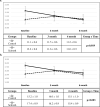Effect of adding Schroth physiotherapeutic scoliosis specific exercises to standard care in adolescents with idiopathic scoliosis on posture assessed using surface topography: A secondary analysis of a Randomized Controlled Trial (RCT)
- PMID: 38687741
- PMCID: PMC11060560
- DOI: 10.1371/journal.pone.0302577
Effect of adding Schroth physiotherapeutic scoliosis specific exercises to standard care in adolescents with idiopathic scoliosis on posture assessed using surface topography: A secondary analysis of a Randomized Controlled Trial (RCT)
Abstract
Background: Adolescent idiopathic scoliosis (AIS) is a three-dimensional structural asymmetry of the spine and trunk affecting 2-4% of adolescents. Standard treatment is observation, bracing, and surgery for small, moderate, and large curves, respectively. Schroth exercises aim to correct posture and reduce curve progression.
Purpose: This study aimed to determine the effect of Schroth exercises added to the standard care compared to standard care alone on torso asymmetry in AIS.
Methods: In a randomized controlled trial (NCT01610908), 124 participants with AIS (age: 10-18, Cobb: 10°-45°, Risser: ≤3) were randomly assigned to the control (Standard care only) or Schroth (Standard care + Schroth treatment) group. Schroth treatment consisted of 1-hour weekly supervised sessions and 30-45 minutes of daily home exercises for six months. The control group received Schroth exercises in the last six months of the 1-year monitoring period. Markerless 3D surface topography assessed torso asymmetry measured by maximum deviation (MaxDev) and root mean square (RMS). Intention to treat linear mixed effects model analysis was compared to the per protocol analysis.
Results: In the intention to treat analysis, the Schroth group (n = 63) had significantly larger decreased RMS (-1.2 mm, 95%CI [-1.5,-0.9]mm, p = 0.012) and MaxDev (-1.9mm, 95%CI [-2.4,-1.5]mm, p = 0.025) measurements compared to controls (n = 57) after six months of intervention. In the per protocol analysis (Schroth n = 39, control n = 36), the Schroth group also had a significantly larger decrease compared to the control in both the RMS (-1.0mm, 95%CI [-1.9, -0.2]mm, p = 0.013) and MaxDev measurements (-2.0mm, 95%CI [-3.3,-0.5]mm, p = 0.037). For the control group, both the intention to treat and per protocol analysis showed no difference in RMS and MaxDev in the last six months of Schroth intervention (p>0.5).
Conclusion: Schroth Exercise treatment added to standard care (observation or bracing) reduced asymmetry measurements in AIS. As expected, a greater effect was observed for participants who followed the prescribed exercise treatment per protocol.
Copyright: © 2024 Mohamed et al. This is an open access article distributed under the terms of the Creative Commons Attribution License, which permits unrestricted use, distribution, and reproduction in any medium, provided the original author and source are credited.
Conflict of interest statement
The authors of this manuscript have the following competing interests: Dr. Parent is a Schroth certified therapist. Dr. Schreiber became an International Schroth Scoliosis Therapy (ISST) instructor and opened the Curvy Spine clinic after the data for this project had been collected. This does not alter our adherence to PLOS ONE policies on sharing data and materials.
Figures







References
-
- Rogala EJ, Drummond DS, Gurr J. Scoliosis: incidence and natural history. A prospective epidemiological study. J Bone Joint Surg Am. 1978;60:173–176. - PubMed
-
- Diagnosis And Treatment | Scoliosis Research Society [Internet]. [cited 2023 Oct 26]. Available from: https://www.srs.org/Patients/Diagnosis-And-Treatment.
-
- Fusco C, Zaina F, Atanasio S, et al.. Physical exercises in the treatment of adolescent idiopathic scoliosis: an updated systematic review. Physiother Theory Pract. 2011;27:80–114. - PubMed
Publication types
MeSH terms
LinkOut - more resources
Full Text Sources
Medical
Research Materials

